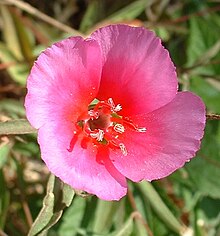Clarkia amoena (farewell to spring, godetia, or satin flower; syn. Godetia amoena) is a flowering plant native to western North America, found in coastal hills and mountains from British Columbia south to the San Francisco Bay Area of California.
| Clarkia amoena | |
|---|---|

| |
| Scientific classification | |
| Kingdom: | Plantae |
| Clade: | Tracheophytes |
| Clade: | Angiosperms |
| Clade: | Eudicots |
| Clade: | Rosids |
| Order: | Myrtales |
| Family: | Onagraceae |
| Genus: | Clarkia |
| Species: | C. amoena
|
| Binomial name | |
| Clarkia amoena (Lehm.) A.Nels. & J.F.Macbr
| |
Description
editIt is an annual plant growing to 1 m tall, with slender, linear leaves 2–7 cm long and 2–6 mm broad. The flowers are pink to pale purple, with four broad petals 1.5–6 cm long. The fruit is a dry capsule, which splits open when mature to release the numerous seeds.
Taxonomy
editFive subspecies are currently recognised, although intermediate forms are commonly found[1]:
- Clarkia amoena subsp. amoena (Lehm.) A. Nelson & J. F. Macbr. – (farewell to spring)[2]
- Clarkia amoena subsp. caurina (Abrams) C.L. Hitchc. – (northwestern farewell to spring)[3]
- Clarkia amoena subsp. huntiana (Jeps.) F.H. Lewis & M.E. Lewis – (Hunt's clarkia)[4]
- Clarkia amoena subsp. lindleyi (Dougl.) C.L. Hitchc. – (Lindley's clarkia)[5]
- Clarkia amoena subsp. whitneyi (A. Gray) H. Lewis & M. Lewis. – (Whitney's farewell to spring)[6]
Cultivation
editFarewell to spring is commonly cultivated as a garden plant, and cultivated varieties are known.
It a cool season plant and will tolerate temperatures below 0 °C (32 °F) in gardens or greenhouses. It is a facultative long day plant, i.e., it flowers faster under long day conditions but long days are not necessary for flowering.[7] The plants grow best with minimal fertilizer rates compared to most other cut flower and flowering potted plant species. Sakata Seed Co. developed cut flower (tall; 'Grace') and flowering potted plant (short; 'Satin') cultivars introduced in the 1980s that offer great performance and uniformity.
A gallery of satin flower cultivars is presented below.
-
'Cattleya'
-
'Duke of York'
-
'Furora'
-
'Grace Lavender with Eye'
-
'Grace Lavender'
-
'Grace Red'
-
'Grace Rose Pink'
-
'Grace Salmon'
-
'Kelviden Glory'
-
'Kyohuhai'
-
'Maidenblush'
-
'Miss Nagasaki'
-
'Sweetheart'
-
'White Bouquet'
-
Clarkia amoena at Gamble Garden in Palo Alto, California
References
edit- ^ Young-Mathews, A. 2012. Plant fact sheet for farewell to spring (Clarkia amoena). USDA-Natural Resources Conservation Service, Corvallis Plant Materials Center, Corvallis, OR.
- ^ "Clarkia amoena ssp. amoena Calflora". www.calflora.org. Retrieved 2024-07-01.
- ^ "OregonFlora | Clarkia amoena ssp. caurina". oregonflora.org. Retrieved 2024-07-01.
- ^ "OregonFlora | Clarkia amoena ssp. huntiana". oregonflora.org. Retrieved 2024-07-01.
- ^ "E-Flora BC Atlas Page | Clarkia amoena subsp. lindleyi". linnet.geog.ubc.ca. Retrieved 2024-07-01.
- ^ "Clarkia amoena ssp. whitneyi Calflora". www.calflora.org. Retrieved 2024-07-01.
- ^ Utami, L., Anderson, R. G., Geneve, R. L., & Kester, S. (1990). Effect of supplemental and photoperiodic lighting on flowering of satin flower. HortScience, 25(9), 1090c-1090.
External links
edit- Jepson Flora Project: Clarkia amoena
- Clarkia amoena at CalPhotos, UC Berkeley
- Plants of British Columbia: Clarkia amoena Archived 2016-03-03 at the Wayback Machine
- Pink, A. (2004). Gardening for the Million. Project Gutenberg Literary Archive Foundation.
